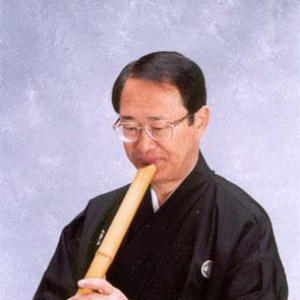
| Trackimage | Playbut | Trackname | Playbut | Trackname |
|---|---|---|---|---|
| 21005647 | Play | Shingetsu Cho | 07:15 Tools | |
| 21005641 | Play | Shika No Tone | 07:46 Tools | |
| 21005644 | Play | Hon Shirabe | 05:43 Tools | |
| 21005645 | Play | Tsuru No Sugomori | 11:29 Tools | |
| 21005643 | Play | Koku | 15:39 Tools | |
| 21005646 | Play | Yamagoe | 04:52 Tools | |
| 21005649 | Play | San'an | 07:52 Tools | |
| 21005642 | Play | Ukigumo | 11:29 Tools | |
| 21005648 | Play | Shikyoku Ichiban, "Poeme I pour shakuhachi et koto" | 15:37 Tools | |
| 21005652 | Play | San'An (Wish for an Easy Delivery) | 07:51 Tools | |
| 21005654 | Play | Yamagoe (Beyond the Mountain) | 04:51 Tools | |
| 21005655 | Play | Hon Shirabe (Basis for Enlightment) | 05:43 Tools | |
| 21005650 | Play | Ukigumo (Floating Clouds) | 11:29 Tools | |
| 21005653 | Play | San An | 07:51 Tools | |
| 21005651 | Play | Tsuru No Sugomori (Nesting of Cranes) | 11:29 Tools | |
| 21005658 | Play | Shika No Tone (Distant Calls of Deer) | 07:46 Tools | |
| 21005657 | Play | Shingetsu Cho (Mode of the Moon in the Earth) | 07:15 Tools | |
| 21005660 | Play | Shingetsu Cho (Mode Of The Moon In The Heart) | 07:15 Tools | |
| 21005659 | Play | Koku (The Empty Sky) | 15:38 Tools | |
| 21005665 | Play | Hon Shirabe (Basis Of Enlightment) | 05:43 Tools | |
| 21005663 | Play | Shika no Tone (Distant Calls Of The Dear) | 07:47 Tools | |
| 21005661 | Play | Honshirabe (Basis for Enlightenment) | 05:44 Tools | |
| 21005656 | Play | Shakuhachi | 15:38 Tools | |
| 21005672 | Play | Hon Shirabe (original tuning) | 05:18 Tools | |
| 21005668 | Play | Shingetsu (Heart Moon) | 06:18 Tools | |
| 21005679 | Play | Nesaza Shirabe | 02:57 Tools | |
| 21005664 | Play | Hon Shirabe (Basis for Enlightenment) | 05:43 Tools | |
| 21005675 | Play | Koku (Empty Sky) | 13:37 Tools | |
| 21005678 | Play | Tamuke (Offerings) | 05:35 Tools | |
| 21005674 | Play | Sigari Ha (Falling Leaf) | 03:51 Tools | |
| 21005669 | Play | Daha No Kyoko (PoundingWave Piece) | 05:14 Tools | |
| 21005682 | Play | Yamagoe (Going Over the Mountian) | 04:18 Tools | |
| 21005673 | Play | Kokuu (Empty Sky): Koku (The Empty Sky) | 15:39 Tools | |
| 58846611 | Play | Yamagoe (Going over the Mountain) | 15:39 Tools | |
| 21005666 | Play | Kokû (The Empty Sky) | 15:38 Tools | |
| 21005677 | Play | 本調 Hon Shirabe [Basis for enlightment] | 05:43 Tools | |
| 58846612 | Play | 浮雲 Ukigumo [Floating clouds] | 05:43 Tools | |
| 21005670 | Play | 鈴法 Yamagoe [Beyond the mountain] | 04:51 Tools | |
| 21005667 | Play | Shingetsu chô (Mode of the moon in the heart) | 07:15 Tools | |
| 21005662 | Play | Shika no tône (Distant calls of deer) | 07:46 Tools | |
| 58846613 | Play | Shika No Tone (Distant Cry of the Deer) | 07:46 Tools | |
| 58846614 | Play | 鶴の巣籠 Tsuru No Sugomori [Nesting of cranes] | 07:46 Tools | |
| 58846615 | Play | Tsuru no Sugomori (Nesting Of | 07:46 Tools |

-
- 34,336
- plays
-
- 5,870
- listners
-
- 34336
- top track count
Tadashi Tajima (田嶋直士) was born in Sakai, Osaka in 1942. He began to study shakuhachi upon entering the Kinko School, where he trained with Chikuho Sakai in mastering the classical shakuhachi honkyoku (the term honkyoku refers to the solo shakuhachi music that was developed in the 17th and 18th centuries by Zen monks as a form of spiritual practice and meditation). Later in Tajima's development, Sakai was moved by Tajima's passion for playing and introduced him to a new master, Katsuya Yokoyama. At the age of 29, Tajima began studying with Yokoyama who, although originally from the Kinko School, had studied a number of years with an idiosyncratic musician by the name of Watazumi who emphasized using very long flutes and added a lot of breathiness to the resulting sound. Yokoyama made this style popular among shakuhachi players and devotees, and Tajima is considered to be one of his best and most well-known students. Mr. Tajima has performed and traveled around the world, including North America, China, Europe and Australia. He was awarded the grand prize for traditional Japanese music at the Pan Musik Festival, and the achievement award for Osaka's Theatrical and Musical Arts Organization. In addition to traditional concert settings, Mr. Tajima has also experimented with playing the shakuhachi in various spatial and sonic locations including an oratory at a Shinto shrine, on the surface of a lake, and inside a cave. Read more on Last.fm. User-contributed text is available under the Creative Commons By-SA License; additional terms may apply.